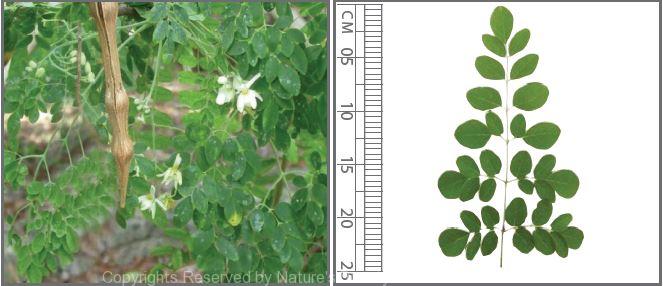

Traditional Knowledge
Useful plant parts :
Leaf, bark, root, flower and seed
Uses in traditional medicine :
- Decoction of the root is taken to increase urination
- Crushed leaves are applied on glandular swellings
- Leaves are purgative and counteracts poisonous effects
- Fruit is used for liver and pancreatic diseases
- Leaves, bark, roots, flowers and seeds are used to cure fever, epilepsy, sores in the mouth and leprosy
- Roots are antiscorbutic and rubefacient and used to treat asthma, gout, rheumatism, enlarged spleen and liver, calculus ailments and dropsy
Scientific Research
Chemical constituents:
Benzyl carbamate derivatives: niazimicin, niazirin, 4(α-L-rhamnosyloxy)-benzyl isothiocyanate and glycerol-1-(9-octadecanoate) from seeds; alkaloid: vincosamide from leaves
Bioactivity :
Aqueous and alcohol extracts of leaves: hypocholesterolaemic, antioxidative; infusion of seed: antispasmodic, anti-inflammatory and antidiuretic; niazimicin: antitumour; 4(α-L-rhamnosyloxy)-benzyl isothiocyanate: antimicrobial; alcohol extract of bark: reduces insulin resistance, antiulcer; vincosamide: cardioprotective
Clinical:
References : Choudhary, M. K. et al., (2013), Assessment of the antiulcer potential of Moringa oleifera root-bark extract in rats, J Acupunct Meridian Stud, 6(4), 214-20. Ciiceres, A. et al., (1992), Pharmacologic properties of Moringa oleifera. 2: Screening for antispasmodic, antiinflammatory and diuretic activity, Journal of Ethnophrmacology, 36, 233-237. Eilert, U. et al., (1981), The Antibiotic Principle of Seeds of Moringa oleifera and Moringa stenopetala, Planta Med, 42(5), 55-61. Ghasi, S. et al., (2000), Hypocholesterolemic effects of crude extract of leaf of Moringa oleifera Lam in high-fat diet fed wistar rats, Journal of Ethnopharmacology, 69, 21–25. Guevara, A. P. et al., (1999), An antitumor promoter from Moringa oleifera Lam., Mutation Research, 440, 181–188 Mishra, G. et al., (2011), Traditional uses, phytochemistry and pharma- cological properties of Moringa oleifera plant: An overview, Der pharmacia lettre, 3(2), 141-164. Padla, E. P. et al., (2012), Antimicrobial isothiocyanates from the seeds of Moringa oleifera Lam, Z Naturforsch C, 67(11-12), 557-64. Panda, S. et al., (2013), Cardioprotective potential of N,α-L-rhamnopyranosyl vincosamide, an indole alkaloid, isolated from the leaves of Moringa oleifera in isoproterenol induced cardiotoxic rats: in vivo and in vitro studies, Bioorg Med Chem Lett, 23(4), 959-62. Siddhuraju, P. and Becker, K., (2003), Antioxidant Properties of Various Solvent Extracts of Total Phenolic Constituents from Three Different Agroclimatic Origins of Drumstick Tree (Moringa oleifera Lam.) Leaves, Journal of Agricultural Food Chemistry, 51(8), 2144–2155. Sholapur, H. N. and Patil, B. M., (2013), Effect of Moringa oleifera bark extracts on dexamethasone-induced insulin resistance in rats, Drug Res (Stuttg), 63(10), 527-31.
Copyrights Reserved By
Natures Beauty Creations



